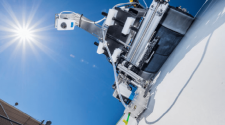This week, Microsoft finally provided a more concrete set of information about its next-generation video game platform — although not as much detail as many were hoping for.
In some regards, Microsoft’s reveal was quite similar to their immediate competitors. Scarlett is, per Microsoft’s statements in its Scarlett reveal, a system on a chip, or SOC, based platform, meaning that the main processor, or CPU, and graphics processing unit, or GPU, are integrated. This reflects the same design methodology as the Xbox One and PlayStation 4 families of consoles and puts to rest rumors of strange, dedicated designs for the new Xbox that have been rumored in the last several months. It will use technology based on AMD’s Zen 2 line of CPUs and its next-generation Navi GPU family. All of this is in keeping with Sony’s April reveal of its upcoming PlayStation console, whose hardware designs are also based around Navi and Zen 2.
However, Microsoft has not provided more detailed specifics about their CPU and GPU, instead providing somewhat vague messaging comparing Scarlett to the Xbox One X, which released in late 2017.
Microsoft is calling Scarlett “a bigger leap than any generation we’ve done before,” specifying that from a “pure processing perspective, [Scarlett is] four times more powerful than Xbox One X.” Today, Variety was able to confirm with Microsoft that this number was specifically in reference to Scarlett’s CPU, and not it’s graphical horsepower, which we still know very little about.
To put this into perspective, the Xbox One X’s CPU element consists of an 8-core, “Jaguar” CPU clocked at 2.3ghz. The Jaguar line of processors is “single-threaded,” meaning each core is considered a single, “logical” processor by a PC or console’s operating system. AMD’s Zen and Zen 2 family of processors support simultaneous multi-threading, or SMT, which means to game software, every core in a Zen processor is functionally two logical processors.
In addition, the basic overall performance improvements in AMD’s CPU architecture between 2012, when the Xbox One and Xbox One X’s processors were first introduced, and Zen 2, which represents the bleeding edge of AMD’s CPU know-how. With that in mind, a 4X improvement in processor performance from Xbox One X to Scarlett seems almost conservative — and something we’ll almost certainly see in the PlayStation 5 as well.
This much more powerful processor is a contributor to some of Microsoft’s other promises, including support for 120FPS visuals, and, like the Xbox One X, support for variable refresh rates for displays that allow the feature. Like Sony, Microsoft is also promising support for 8K displays, though it’s highly unlikely many games will natively support the 4x increase in resolution over the already 4x increase in resolution that 4K offers over 1080p content. CPU speed has been a major constraint on framerates and world complexity during this console generation, suggesting this could be a particular avenue of improvement in next-generation software.
Sony’s biggest promises in their exclusive reveal with Wired related to the new console’s custom built, solid-state storage solution, which promised to dramatically improve load times and world-streaming speeds in open-world games like Marvel’s Spider-Man, which Sony used to demonstrate the technology. Microsoft also revealed that Project Scarlett will employ a custom, solid state drive that offers up to 40x faster read speeds than the storage in current generation Xbox One consoles. Current generation consoles use 5400 RPM mechanical hard drives that offer read speeds of approximately 80MBps, while high-end NVME drives — solid state storage devices that connect directly to a PC’s mainboard, rather than through cable connections — offer read speeds of 3200MBps (or 3.2GBps), a number that comfortably fits into Microsoft’s claims of a 40x increase.
Like Sony, Microsoft’s Scarlett announcement also committed the platform holder to support for real-time ray tracing on its new console. However, Sony’s phrasing left some questions open as to whether the new PlayStation would feature hardware specifically designed to support the cutting edge graphics tech, or merely support a more generalized implementation of it. Microsoft was more firm in its commitment, stating in its presentation that Scarlett would feature “real-time, hardware accelerated ray tracing.” This announcement has been further complicated by AMD’s reveal of its Navi GPUs this week, which apparently do not include hardware dedicated to real-time ray tracing, unlike Nvidia’s RTX series of video cards. The question, then is whether or not Microsoft has integrated its own additional, dedicated ray tracing hardware in Scarlett.
Microsoft also committed to backward compatibility for the next generation of Xbox with particularly strong language, claiming Scarlett would offer “four generations of content, better than you’ve ever seen them before.” This would seem to imply that current generation Xbox games, as well as Xbox 360 and original Xbox titles, would offer improved visuals and performance on Scarlett, in much the same way the Xbox One X allows for a 9x resolution increase on some games, as well as more basic graphical improvements on all titles. This also suggests parity with the way backward compatibility works on the Xbox One, in which digitally owned previous generation titles simply appear in a user’s library on the current generation console.
More surprisingly, in an almost unprecedented move, it would appear that Microsoft has committed to full backward compatibility for Xbox One’s accessories and peripherals for Xbox Scarlett. “I don’t lose my last generation as I move into the next generation, and the people I play with and the games I want to play, that experience should be continuous and always growing,” stated Xbox head Phil Spencer.
Another Xbox team member was even more specific. “Your games, your achievements, your progression, your accessories, your console gaming experience on Xbox, it all comes forward with Scarlett,” they said.
Many of the same caveats that applied to Sony’s announcement of new PlayStation hardware still apply, and then some. Scarlett’s hardware likely isn’t completely final at this time. Overall clock speeds for its GPU and CPU elements are likely still being finalized as Microsoft determines how successful manufacturing will be, and, if its previous history with the Xbox One X is any indication, how involved Scarlett’s cooling solution can or even must be. The Xbox One X achieves its performance numbers in large part because of an aggressive, “vapor chamber” cooling solution custom tailored to each console. To quote myself, shipping new console hardware is like trying to land a plane on a moving target — sometimes things must change, and it makes little sense for Microsoft (or Sony) to commit to numbers that may change, up or down.
Missing from Microsoft’s press conference was any mention of the oft-rumored two-console strategy Microsoft is allegedly considering for the next console generation. It has been reported that there are in fact two next-generation Xbox consoles in development — one, codenamed Anaconda, is a high-end, 4K-aimed beast of a machine, with a lower-spec’ed, 1080p oriented device codenamed Lockhart also planned. We’ll have to wait to find out if this is still Microsoft’s plan for the platform. Project Scarlett — or whatever the actual name for the next-generation Xbox ends up being — will release in the Holiday window of 2020.

















